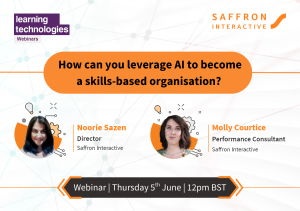With digital disruption more prevalent than ever, upskilling and career adaptability have become buzzwords for employees and employers alike. And rightly so.
Upskilling can not only reduce costs, but boost employee satisfaction and productivity, and provide you with a competitive advantage in the marketplace! Building career adaptability, within the workforce ensures your employees have the skills and mind-set required to survive in the ever-changing landscape. It is a powerful combination and win-win for those organisations that are forward thinking and invest in creating this ecosystem.
But upskilling can be difficult. There are not always the resources, be it time or budget, to allocate to training existing (or even future) employees. So how can you set up your workforce in a way that ensures learning can happen effectively without disrupting the normal workflow? How can you hone in on discovering the most suitable candidates for a new role and maximise your employees’ potential? In other words: are your employees in the right shape?
The right shape?
Let’s go back a bit. If you’re not familiar with categorising employees as shapes, you might be completely lost right now. It all started with the term and describes people with a deep technical or other specialism in one area (the ‘stem’) who also expand their expertise beyond their focus area to apply their skills within adjacent specialisms – the top part of the T. This model was used to make it easier to categorise potential employees from their I-shaped counterparts, who were seen as less desirable, as they did not have the ability to advise holistically and see the broader picture.
However, this model is now not enough. Essentially, people will need to evolve their specialisms and their breadth of knowledge to encompass multiple specialisms and related adjacent, now popularly known as M-shaped people. This is how people are needing to be now in terms of career adaptability. But less common still, are the E-shaped people – symbolising employees that not only have experience and expertise but are able to execute on those separate specialisms.
Shapes of the Future
Recognising employee’s shapes is all well and good, but which ones are going to shape the future? As you might have guessed, E-shaped people are predicted to become the foundation of workforces in the coming years. Particularly due to their curious and hands-on nature, E-shaped people will do well in a future that is built on constant change and evolvement.
Furthermore, this shape lends itself well to the so-called ‘portfolio careers’ that are likely going to be common in tomorrow’s job market. A ‘job for life’ is already outdated, but the future means individuals will have a number of different careers throughout their life, perhaps even overlapping each other, so agility is key. So, to thrive as an organisation you will want to ensure that your employees (old and new) have the skills required to blossom in the new landscape and be able to adapt to whatever might come.
Though the positive benefits of further learning and ‘shaping’ are evident, many organisations hesitate to upskill, worrying that hard-earned, upskilled employees will move onto competitors. But in fact, the opposite is true; by providing employees with opportunities to extend and apply their new knowledge, they have the chance to recognise their own value within the business and perhaps even pass it onto others. This in turn, leads to higher satisfaction rates, which, makes switching employers less attractive.

Fostering an agile workforce
There is an abundance of approaches out there that you can take to train your own staff. But one noteworthy example of low-cost, efficient upskilling comes from Google. In recent years, they have implemented what they call their “g-2-g” (Googler-to-Google) program, which is a voluntary network of 6,000-plus employees. There, employees can teach and train each other in a variety of ways such as teaching courses and 1:1 mentoring. The initiative has yielded impressive results with 80% of all tracked training at Google being done through this network.
Building a social learning network like Google is a great approach if you are looking to upskill your employees cost-effectively and build a learning culture. And the cherry on top: an unconstrained structure like this encourages the forming of E-shaped people, due to its self-motivated nature which fosters exploration by providing people’s expertise and experience to others outside their field.
However, a network like this cannot stand on its own. To effectively transform your workforce into E-shaped employees, you’ll want to make sure that they do not only have opportunities to learn from their peers but also provide them with further training such as elearning courses, blended learning and so on.
To assure that learners don’t lose sight of their long-term goals and the steps to get there, it’s wise to supplement their learning with mentor check-ins. These offer a great opportunity to regroup and realign any training with the individual’s needs and ambitions, as well as the organisations goals.
At Saffron, these are principles that we integrate into everything we do, such as our Create Your Own Future platform. Here, users’ experiences and skills are evaluated and applied to potential careers, even outside their previous field. A mentor guides the learner throughout their journey and a personalised dashboard ensures learners are kept on track with their goals.
Conclusion
As the career landscape changes more and more from stability to mobility, adaptability becomes increasingly important, yet many employees lack the agility needed to navigate the ever-changing tides of the market. By developing your employees into E-shaped people, you are not only providing them with the tools they need to survive any disruption but thrive on it. To make their learning as succinct and effective as possible you’ll want to ensure to supply a blend of resources, ranging from internal exchanges to external learning modules while providing mentor support along the way.
Check out our Career Adaptability Hub for more resources. Not quite sure how to transform your employees into the agile workforce that they could be? Chat to us, we’d love to talk!




